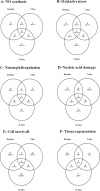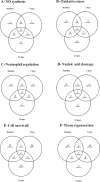Hydrogen peroxide-based products alter inflammatory and tissue damage-related proteins in the gingival crevicular fluid of healthy volunteers: a randomized trial
- PMID: 30837573
- PMCID: PMC6400941
- DOI: 10.1038/s41598-019-40006-w
Hydrogen peroxide-based products alter inflammatory and tissue damage-related proteins in the gingival crevicular fluid of healthy volunteers: a randomized trial
Abstract
Hydrogen peroxide (H2O2)-based products are effective in tooth whitening; however, their safety is controversial as they may harm patient tissues/cells. These effects are suggested to be concentration-dependent; nonetheless, to date, there are no reports on H2O2-mediated oxidative damage in the gingival tissue, and neither whether this can be detected in gingival crevicular fluid (GCF) samples. We hypothesize that H2O2 whitening products may cause collateral oxidative tissue damage following in office application. Therefore, H2O2 and nitric oxide (NO) levels were investigated in GCF samples obtained from patients undergoing dental bleaching with H2O2 at different concentrations, in a randomized, double-blind, split-mouth clinical trial. A proteomic analysis of these samples was also performed. H2O2-based whitening products promoted inflammation which was detected in GCF samples and lasted for longer following 35% H2O2 bleaching. This included time-dependent changes in NO levels and in the abundance of proteins associated with NO synthesis, oxidative stress, neutrophil regulation, nucleic acid damage, cell survival and/or tissue regeneration. Overall, H2O2-based products used in office promote inflammation irrespective of their concentration. As the inflammation caused by 35% H2O2 is longer, patients may benefit better from using lower concentrations of this bleaching product, as they may result in less tissue damage.
Conflict of interest statement
The authors declare no competing interests.
Figures



Similar articles
-
Evaluation of several clinical parameters after bleaching with hydrogen peroxide at different concentrations: A randomized clinical trial.J Dent. 2018 Jan;68:91-97. doi: 10.1016/j.jdent.2017.11.008. Epub 2017 Nov 21. J Dent. 2018. PMID: 29169968 Clinical Trial.
-
The effect of bleachıng systems on the gingiva and the levels of IL-1β and IL-10 in gingival crevicular fluid.Oper Dent. 2011 Nov-Dec;36(6):572-80. doi: 10.2341/10-058-C. Epub 2011 Sep 13. Oper Dent. 2011. PMID: 21913862 Clinical Trial.
-
Effect of different bleaching techniques on DNA damage biomarkers in serum, saliva, and GCF.Hum Exp Toxicol. 2021 Aug;40(8):1332-1341. doi: 10.1177/0960327121996030. Epub 2021 Feb 24. Hum Exp Toxicol. 2021. PMID: 33622079 Clinical Trial.
-
Biomaterials based on advanced oxidation processes in tooth whitening: fundamentals, progress, and models.J Mater Chem B. 2024 Oct 2;12(38):9459-9477. doi: 10.1039/d4tb01311e. J Mater Chem B. 2024. PMID: 39193628 Review.
-
Biological action of bleaching agents on tooth structure: A review.Histol Histopathol. 2024 Oct;39(10):1229-1243. doi: 10.14670/HH-18-726. Epub 2024 Feb 28. Histol Histopathol. 2024. PMID: 38477344 Review.
Cited by
-
Oxygen-Releasing Hyaluronic Acid-Based Dispersion with Controlled Oxygen Delivery for Enhanced Periodontal Tissue Engineering.Int J Mol Sci. 2023 Mar 21;24(6):5936. doi: 10.3390/ijms24065936. Int J Mol Sci. 2023. PMID: 36983008 Free PMC article.
-
Effect of gingival barrier brands on operator perception, cervical adaptation, and patient comfort during in-office tooth bleaching: a randomized clinical trial.BMC Oral Health. 2024 Jan 28;24(1):139. doi: 10.1186/s12903-024-03900-y. BMC Oral Health. 2024. PMID: 38281911 Free PMC article. Clinical Trial.
-
Ex vivo study of molecular changes of stained teeth following hydrogen peroxide and peroxymonosulfate treatments.Sci Rep. 2023 Sep 28;13(1):16349. doi: 10.1038/s41598-023-43201-y. Sci Rep. 2023. PMID: 37770593 Free PMC article.
-
Influence of smoking on oral cells genotoxicity after at-home bleaching using 22% carbamide peroxide: a cohort study.Clin Oral Investig. 2022 Feb;26(2):1409-1416. doi: 10.1007/s00784-021-04115-z. Epub 2021 Aug 17. Clin Oral Investig. 2022. PMID: 34405310 Free PMC article.
-
Piezo-catalysis for nondestructive tooth whitening.Nat Commun. 2020 Mar 12;11(1):1328. doi: 10.1038/s41467-020-15015-3. Nat Commun. 2020. PMID: 32165627 Free PMC article.
References
-
- Aushill TM, Hellwig E, Schmidale S, Sculean A, Arweiler NB. Efficacity, side effects and patients’ acceptance of diferente bleaching techniques (OTC, in-office, at-home) Oper. Dent. 2005;30:156–163. - PubMed
-
- Basting RT, Amaral FL, Franca FM, Flório FM. Clinical comparative study of the effectiveness of and tooth sensitivity to 10% and 20% carbamide peroxide home-use and 35% and 38% hydrogen peroxide in-office bleaching materials containing desensitizing agents. Oper. Dent. 2012;37:464–473. doi: 10.2341/11-337-C. - DOI - PubMed
Publication types
MeSH terms
Substances
LinkOut - more resources
Full Text Sources
Research Materials

